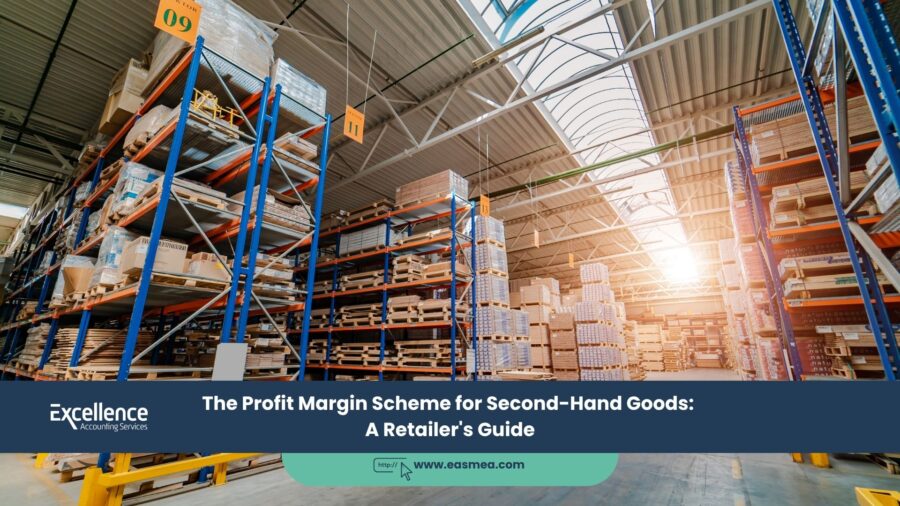The Profit Margin Scheme for Second-Hand Goods: A Retailer’s Guide
For businesses in the UAE that trade in second-hand goods—such as used car dealerships, antique shops, and retailers of refurbished electronics—the standard VAT rules can create a significant challenge. Normally, a business charges 5% VAT on the full selling price of an item. But what happens when you buy a used item from a non-registered individual who didn’t charge you any VAT? If you had to charge VAT on the full resale price, you would be at a serious disadvantage, and the tax would be unfairly applied twice on the same goods.
- The Profit Margin Scheme for Second-Hand Goods: A Retailer's Guide
- What is the Purpose of the Profit Margin Scheme?
- Who Can Use the Scheme and for What Goods?
- How to Calculate VAT Under the Scheme: A Step-by-Step Example
- Critical Invoicing and Record-Keeping Rules
- Navigate the Profit Margin Scheme with EAS
- Frequently Asked Questions (FAQs)
- Trading in Second-Hand Goods?
To solve this problem, the Federal Tax Authority (FTA) created the Profit Margin Scheme. This is a special method of accounting for VAT designed specifically for businesses dealing in eligible second-hand goods. Instead of calculating VAT on the full selling price, the scheme allows you to calculate and charge VAT only on your profit margin—the difference between your purchase price and your selling price. This ensures that VAT is only applied to the value you add as a retailer.
This guide will provide a clear, practical walkthrough of the Profit Margin Scheme for UAE retailers. We will explain who is eligible, what goods qualify, how to calculate the tax correctly, and the critical record-keeping requirements you must follow to stay compliant.
Key Takeaways
- VAT is on Profit, Not Price: The scheme allows you to calculate 5% VAT on the difference between your selling price and purchase price, not the full selling price.
- Applies to Eligible Second-Hand Goods: This includes used goods, antiques, and collectors’ items that were purchased from a non-VAT-registered person or another business using the scheme.
- No Input Tax Recovery: When you buy goods that you intend to sell under the scheme, you cannot recover any input VAT on the purchase.
- Specific Invoicing Rules: The invoice you issue to your customer must not show the VAT amount separately. It must be a tax invoice showing a total price inclusive of the VAT on the margin.
- Meticulous Records are Mandatory: You must maintain a detailed stock book and records proving the purchase and selling price of each individual item sold under the scheme.
What is the Purpose of the Profit Margin Scheme?
The primary purpose of the scheme is to prevent double taxation and to ensure fair competition. Without it, the VAT system would be distorted for second-hand goods.
Consider a used car. The first owner bought it new and paid VAT on the full price. When they sell it to a used car dealer, as an individual, they don’t charge VAT. If the dealer then had to charge 5% VAT on the full resale price, the tax would be applied a second time on the car’s original value. The Profit Margin Scheme corrects this by ensuring VAT is only applied to the value added by the dealer—their profit.
The Profit Margin Scheme is a simplifying measure that ensures VAT is only paid on the value created at each stage in the supply chain, which is the core principle of a value-added tax system.
Who Can Use the Scheme and for What Goods?
To use the Profit Margin Scheme, you must be a VAT-registered business that buys and sells eligible goods.
Eligible Goods:
- Second-Hand Goods: Tangible, movable property that is suitable for further use as it is or after repair (e.g., used cars, furniture, electronics).
- Antiques: Goods that are over 50 years old.
- Collectors’ Items: Such as stamps, coins, and other pieces of historical interest.
Eligible Purchases:
Crucially, you can only apply the scheme to the sale of eligible goods that you have purchased from one of the following sources:
- A person who is not registered for VAT (e.g., a member of the public).
- Another VAT-registered business that also sold the item to you under the Profit Margin Scheme.
If you buy a used item from a VAT-registered business that charged you a standard 5% VAT on the full price (e.g., a rental car company selling its old fleet), you cannot use the Profit Margin Scheme when you resell it. In that case, you would recover the input VAT you paid and charge output VAT on your full selling price as normal.
How to Calculate VAT Under the Scheme: A Step-by-Step Example
The calculation is straightforward. Let’s use the example of a used car dealership.
- Purchase the Item: You buy a used car from an individual for AED 50,000. Since the seller is not VAT-registered, no VAT is paid on the purchase.
- Sell the Item: You sell the same car to a new customer for AED 60,000.
- Calculate the Profit Margin:
Selling Price: AED 60,000
Purchase Price: AED 50,000
Profit Margin: AED 10,000 - Calculate the VAT on the Margin: The profit margin is considered to be inclusive of VAT. To find the tax component, you must use the tax fraction:
VAT = Profit Margin × (VAT Rate ÷ (100 + VAT Rate))
VAT = AED 10,000 × (5 ÷ 105)
VAT Due = AED 476.19
In this scenario, you would pay AED 476.19 to the FTA as output tax, not AED 2,857.14 (which would be the VAT on the full selling price of AED 60,000).
Critical Invoicing and Record-Keeping Rules
Compliance with the Profit Margin Scheme hinges on your ability to maintain perfect records. The FTA has very strict requirements.
Invoicing Requirements
When you sell an item under the scheme, you must issue a tax invoice that includes all the standard required information, with one critical difference:
- You must not show the VAT amount separately on the invoice.
- The invoice must show a total amount payable (e.g., AED 60,000) and include a statement such as “Sale under the Profit Margin Scheme.”
This is to protect your commercial interests, as showing the VAT amount would reveal your profit margin to the customer.
Record-Keeping Requirements
You must maintain a stock book or similar record that contains the following details for *every single item* bought and sold under the scheme:
- Purchase details (date, invoice number, supplier name, purchase price).
- Sale details (date, invoice number, customer name, selling price).
- A description of the goods (e.g., car VIN, unique stock number).
- The profit margin and the VAT due on that margin.
Using an accounting system like Zoho Books is essential for maintaining these detailed records in an organized and audit-proof manner.
Navigate the Profit Margin Scheme with EAS
The Profit Margin Scheme offers a significant benefit, but its strict documentation rules can be a compliance trap. The expert VAT consultants at Excellence Accounting Services (EAS) can help you implement and manage the scheme correctly.
Our Services Include:
- Scheme Eligibility Assessment: We can confirm if your business and goods are eligible to use the Profit Margin Scheme.
- Record-Keeping System Setup: We can help you set up your bookkeeping and inventory systems to meet the strict record-keeping requirements of the scheme.
- VAT Return Filing: We ensure that the VAT calculated under the scheme is correctly reported on your quarterly VAT returns.
Frequently Asked Questions (FAQs)
If your selling price is less than your purchase price, your profit margin is zero or negative. In this case, there is no VAT due on the sale. You cannot claim a refund for the loss.
Yes. The use of the Profit Margin Scheme is optional for eligible goods. You can choose to apply the normal VAT rules (charge VAT on the full selling price) for any specific transaction. However, you must apply the chosen method consistently.
No. The Profit Margin Scheme is strictly for the supply of eligible second-hand goods. It cannot be used for any type of service.
The cost of repairs or added parts cannot be included in the purchase price for the margin calculation. The profit margin is always the selling price minus the original purchase price of the item itself. The VAT on the cost of the new parts can be recovered as normal input tax.
No. Because the tax invoice you issue under the scheme does not show a separate VAT amount, the buyer cannot claim any input tax on the purchase.
You must have proof of the purchase price. If the seller cannot provide an invoice, you should create your own self-generated purchase document that includes the seller’s name, address, and signature, along with a description of the goods and the price paid. Without this, you cannot use the scheme.
No, you can apply it on an item-by-item basis. You might have some stock that is eligible for the scheme and other stock (e.g., bought from a VAT-registered supplier) that is not. Your record-keeping must be clear enough to distinguish between the two.
The scheme is a VAT-specific measure. For Corporate Tax purposes, your revenue is your full selling price (e.g., AED 60,000) and your cost of goods sold is your full purchase price (e.g., AED 50,000). The profit for Corporate Tax is the same as your profit margin (AED 10,000).
Yes, provided the goods are eligible and you meet all the record-keeping requirements. You must be able to track the specific purchase and sale price for each individual item sold online.
The biggest risk is inadequate record-keeping. If you are audited by the FTA and cannot produce a clear stock book that links every single sale under the scheme to a specific purchase with a proven purchase price, the FTA will disallow the use of the scheme and will calculate VAT on your full selling price for all those transactions, which can result in a massive tax assessment and penalties.
Conclusion: A Benefit That Demands Discipline
The Profit Margin Scheme is a significant benefit for UAE retailers of second-hand goods, allowing them to operate on a level playing field and avoid unfair taxation. However, this benefit comes with a strict condition: absolute discipline in record-keeping.
By understanding the rules, implementing robust inventory and accounting systems, and maintaining meticulous records for every single transaction, you can confidently and compliantly leverage the scheme to your advantage.
Trading in Second-Hand Goods?
Our VAT experts can help you set up and manage the scheme, protecting you from the risks of poor record-keeping.




